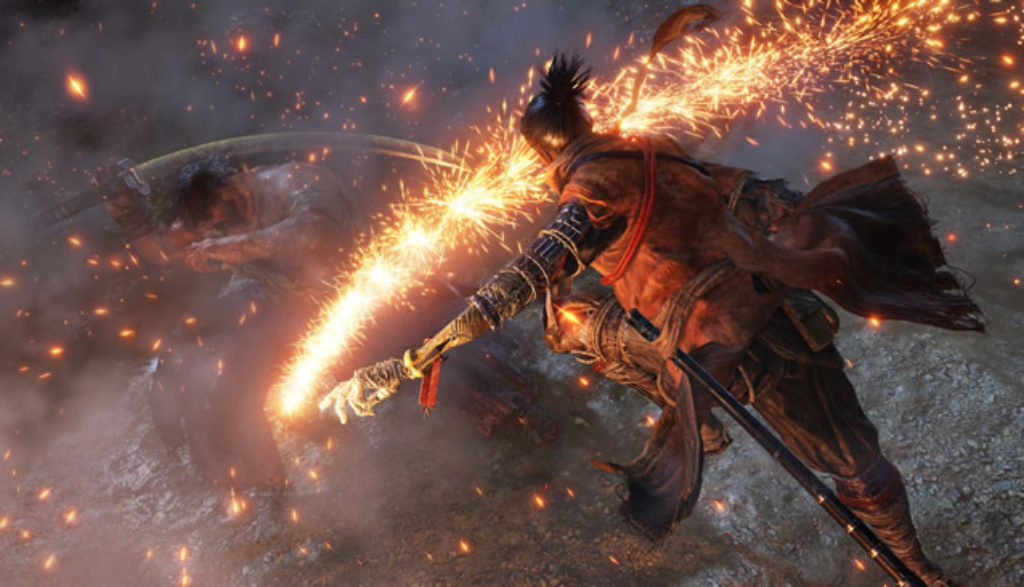
There are a lot of video games out there that you might play just for fun: button-crunchers that offer a quick diversion or a chance to unwind after a long, hard day.
Sekiro: Shadows Die Twice is not one of them.
Like the stygian netherworld Dark Souls series, and other infernal titles birthed by the (rather awkwardly named) gamemakers at FromSoftware, Sekiro is not an endeavor of fun, but of frustration and fury. And the game almost seems proud of it.
You see, Sekiro: Shadows Die Twice is something of a masochistic pursuit that beats you, drawing you close and sneering that you’re not quite good enough. So you come back again and again, laboring for nothing more than the hope of proving the game and its makers wrong. And when you finally succeed …
Then things gets harder.
The central “hero” here is a Shinobi, what we Westerners would call a ninja, who’s determined to serve his young master in feudal Japan. It’s a realm filled with constant war, political intrigue, katana blades and blood. Lots of blood. Playing as a warrior named Sekiro, though, you really only need worry about the bloody blade, for in fact your battered guy doesn’t know or remember much else.
This particular Shinobi is a beaten-down dude who’s lost his memory and his Divine Heir master in a past battle. But when he struggles back to save the boy, he’s bested again and has his left arm lopped off by an overpowering warrior. Fortunately for Sekiro, an aged sculptor with a wood chisel brings him back to health and gives him a mechanical arm that can be used as a multipurpose tool and weapon.
Once he’s up and going again, Sekiro sets off to (hopefully) find the vaunted Ashina castle and once again attempt to save his boy master. Oh, and he must find a way to wreak bloody revenge on every human, beast, grotesquery and pike-swinging spirit he encounters along the way. The ultimate goal? To survive as you attempt to hack your way through this kingdom of enemies.
But as I’ve already alluded, you won’t. Survive, that is.
That prosthetic arm is helpful—initially giving you a great ninja-like grappling hook to enable you to swing and sneak through the twisting trees, weathered temples, high grasses and mountainous regions. And as you find new pieces to weave into the arm’s mechanics, the old sculptor will gift you with such things as the ability to shoot fire or sharp-edged spinning shuriken from your weaponized wood-and-bone prosthesis, or you’ll gain attack-avoiding mystical moves and deflecting shields.
But there are scores and scores of sword-bearing combatants here, as well as some 19 mini-bosses and 17 major bosses, that will thump, hack and gut you into submission nonetheless.
Repeatedly.
As you go, you’ll also find the sculptor’s hand-carved idols here and there. When killed, Sekiro will resurrect at these small statues. They’ll also allow the ninja to essentially teleport between other shrines from that creative wood carver. And if Sekiro prays in those places, he’ll be restored to health, too, while also reviving some defeated enemies. (At other Buddhist idols, Sekira can offer certain spiritual items to regain his lost memories and skills.)
The big difference with this game, as compared to others of its ilk, is that you won’t find or purchase better levels of weapons and armor for the battles on hand. As the opponents become more and more impossible to stand toe to toe with, you can only move forward with improved observation skills and split-second timing.
With only Sekiro’s katana between you and various demon-like foes—ranging from a gigantic white snake, to a headless poison-spewing ape, to a ghostly corrupted monk, to a female swordswoman with blistering speed and magical abilities—you must perfect your parrying skills and dodging abilities, working every possible side-slipping move into a deadly dance. At the same time, you must watch your enemy’s tightly woven move-sets and patterns to find that one tiny opening where a razor-sharp blade might slip through in a heartbeat and strike home.
After experimenting, maneuvering and fighting with a single infuriating boss—sometimes for hours of deaths, resurrections and retries—the final victory blow can feel incredibly satisfying. (Sort of like the sweet relief of lifting a misplaced couch off your foot.) But there’s no question that it takes its muscle-knotting, mind-numbing toll.
On top of that, this is a messy, bloody game. It may be intended as an exotic blend of the spiritually fantastic and the realistically ugly, but the frenetic battles with humans, monsters and beasts are blood-spattering affairs that often end in some kind of dismemberment or decapitation. And even if body parts stay glued on, a driven-home blade will still let loose a goopy-gush equivalent to a small lawn sprinkler in a strong wind.
Sekiro: Shadows Die Twice may not, ultimately, feel as infernally bleak and hopeless as your typical Dark Souls game. But it’s still punishing in nearly every sense of the word, taking its pound of virtual flesh.

After spending more than two decades touring, directing, writing and producing for Christian theater and radio (most recently for Adventures in Odyssey, which he still contributes to), Bob joined the Plugged In staff to help us focus more heavily on video games. He is also one of our primary movie reviewers.